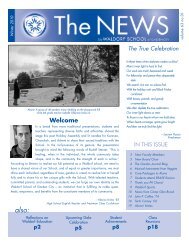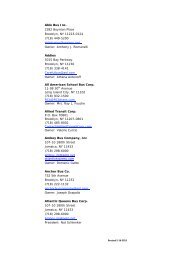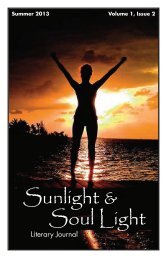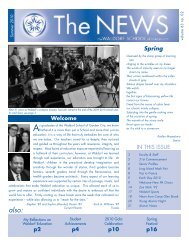The Annual Report
Annual Report 2005-2006.qxd - The Waldorf School of Garden City
Annual Report 2005-2006.qxd - The Waldorf School of Garden City
- No tags were found...
Create successful ePaper yourself
Turn your PDF publications into a flip-book with our unique Google optimized e-Paper software.
Message fromCampGlen Brookb y Tw a i n B r a d e n ‘ 8 8 , D i r e c t o r<strong>The</strong> last 20 yearshas seen muchchange in forestmanagement.Images of greatswaths of clear-cutland, leavingbehind miles ofstumps that would make the Lorax cry,were seen as an inevitable result of anyforestry activities. Not surprisingly,environmentalists and loggers were atodds, each seeing the other’s position asunrealistic and irresponsible. Recently,a more pragmatic view of forestry hasemerged; one that accommodates theeconomic interests of forestedcommunities, where logging jobssupport the economy, while at the sametime taking the long-view towardsustainable land stewardship to protectthe interests of wildlife and reduce theatmosphere's urgent carbon problem.Here at Glen Brook we’ve decidedto participate in this trend byimplementing a forest managementplan and establishing the property as acertified tree farm. This does not meanthat Glen Brook’s forests will be cutdown. It means that the forests will be“managed,” certain trees cut – and soldfor lumber or cordwood – to encouragethe growth of others so that the overallresult maximizes the forest’s potential.<strong>The</strong>re are four prongs to tree farmcertification: wood, water, recreationand wildlife. <strong>The</strong> first, wood, simplymeans the use of wood for building, fuel(maple syrup evaporation and woodstoves), or sale. <strong>The</strong> protection ofwatersheds is equally vital to the plan,since irresponsible forest managementclogs streams, kills fish, and poisonsdrinking water. Recreation can meanhiking or biking trails, camping, or, inGlen Brook’s case, a high- and lowropescourse. <strong>The</strong> wildlife componentinvolves protecting certain habitats asshelter and food sources for nativespecies: hemlock for deer stands andwinter forage; soft-mast berry trees likewild cherry for songbirds and bears;and hard-mast nut trees like hickory,beech and oak for squirrels andchipmunks. Responsible forestry takesyears to implement, yet the small step oftree farm certification will ensurehealthy forests for Camp Glen Brookand all our children.7






